
Here is another great review of the Texas Economy for the month of May 2018 courtesy of Texas A & M University.
Fueled by oil prices of more than $60 per barrel, the Texas economy accelerated its pace of job creation in April 2018. The state gained 332,300 nonagricultural jobs from April 2017 to April 2018, an annual growth rate of 2.7 percent, higher than the nation’s employment growth rate of 1.6 percent (Table 1 and Figure 1). The nongovernment sector added 327,500 jobs, an annual growth rate of 3.2 percent, also higher than the nation’s employment growth rate of 1.8 percent in the private sector (Table 1).
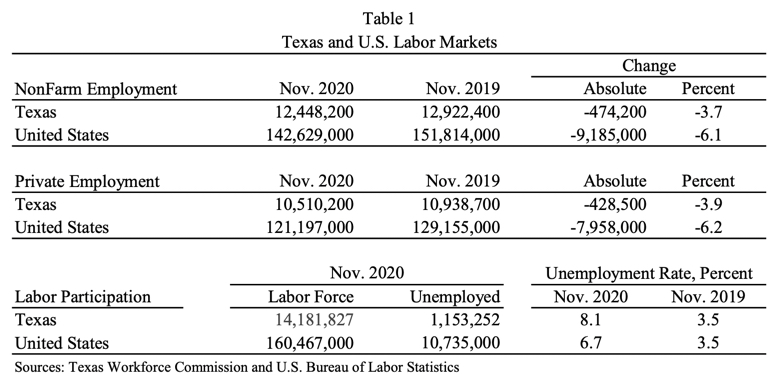

Texas’ seasonally adjusted unemployment rate in April 2018 was 4.1 percent, lower than the 4.5 percent rate in April 2017. The nation’s rate decreased from 4.4 to 3.9 percent (Table 1).
Texas Employment Growth Rates by Industry
Table 2 shows Texas industries ranked by employment growth rate from April 2017 to April 2018. All Texas industries except the information industry had more jobs in April 2018 than in April 2017. The mining and logging industry ranked first in job creation followed by construction; professional and business services; transportation, warehousing, and utilities; leisure and hospitality; manufacturing; and financial activities. Figures 2 to 13 (shown in full report) show trends in employment growth rates by industry.
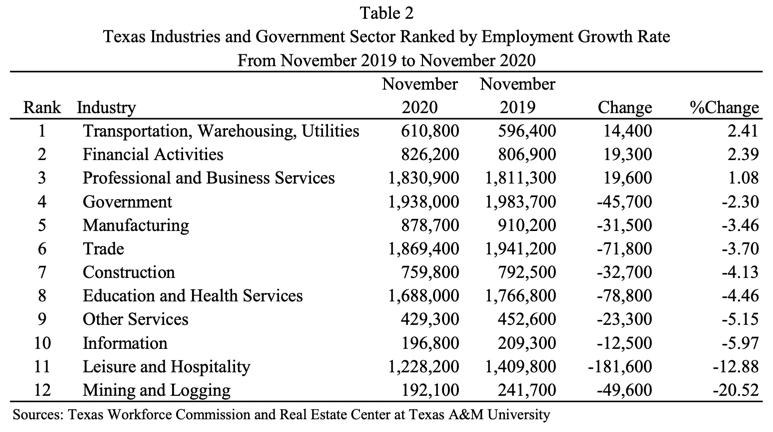
Texas Job Shares by Industry and the Government Sector
Table 3 shows Texas industries and the state’s government sector ranked by their shares of Texas jobs in April 2018. Of the 12,507,500 nonagricultural jobs in April 2018, the highest percentage of employment by industry was in the trade industry and government sector followed by professional and business services, education and health services, leisure and hospitality, and manufacturing. Since April 2017, professional and business services; leisure and hospitality; manufacturing; construction; transportation, warehousing, and utilities; and mining and logging have expanded their shares of Texas employment at the expense of the government sector, trade, education and health services, financial activities, other services, and the information industry. Figures 14 to 25 (shown in full report) show trends in shares of total Texas jobs by industry.

Contributions to Texas Employment Growth Rate by Industry
Texas’ statewide employment growth rate of 2.7 percent, or more exactly 2.7293 percent, from April 2017 to April 2018 is the weighted average of employment growth rates for all Texas industries for the period. Weights are shares of jobs by industry. The contribution of each industry to the statewide employment growth rate is equal to the employment growth rate of that industry multiplied by its share of Texas jobs. Table 4 shows Texas industries and the state’s government sector ranked by their contributions to Texas employment growth rates from April 2017 to April 2018. The state’s professional and business services ranked first in contribution to job growth followed by leisure and hospitality; construction; trade; education and health services; manufacturing; and mining and logging. Figures 26 to 37 (shown in full report) show trends in contributions of Texas industries to Texas job growth rates.

Employment Growth Rates by Texas Metropolitan Areas
All Texas metro areas except Beaumont-Port Arthur, Corpus Christi, and Victoria had more jobs in April 2018 than in April 2017 (Table 5). Midland ranked first in job creation followed by Odessa, College Station-Bryan, Dallas-Plano-Irving, Austin-Round Rock, Fort Worth-Arlington, and Houston-The Woodlands-Sugar Land. Figures 38 to 63 (shown in full report) show trends in annual employment growth rates for the state’s metropolitan areas.
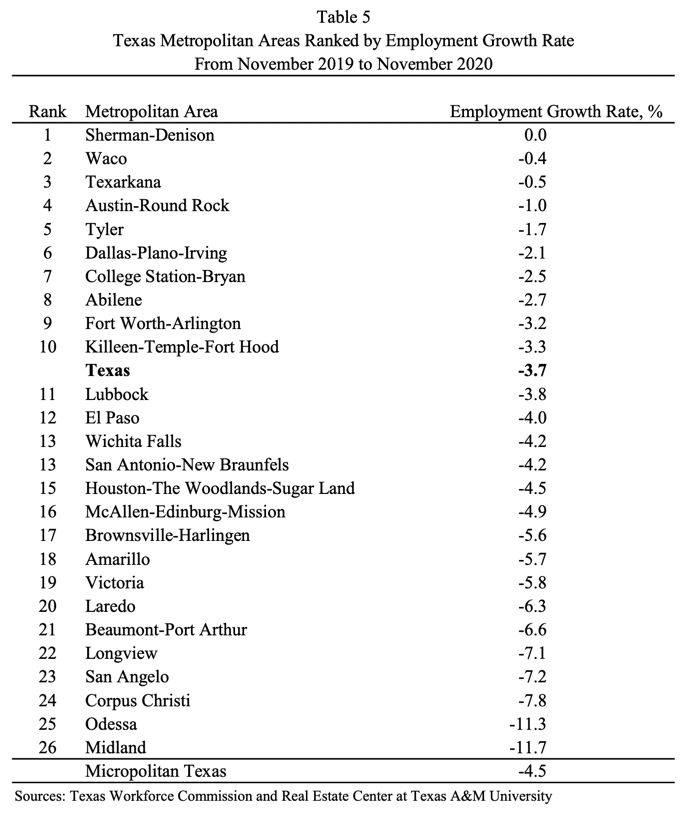
Texas Job Shares by Metropolitan Area
Table 6 shows Texas metropolitan areas ranked by their shares of total Texas jobs in April 2018. Houston-The Woodlands-Sugar Land had the largest share of Texas jobs followed by Dallas-Plano-Irving, Austin-Round Rock, San Antonio-New Braunfels, Fort Worth-Arlington, El Paso, and McAllen-Edinburg-Mission. Figures 64 to 89 (shown in full report) show trends in metropolitan shares of total Texas jobs.

Contributions to Texas’ Employment Growth Rate by Metropolitan Area
The statewide employment growth rate of 2.7293 percent in Texas from April 2017 to April 2018 is the weighted average of employment growth rates of all Texas metros for the period. Weights are shares of jobs by area. The contribution of each metro to the statewide employment growth rate is equal to the employment growth rate in that area multiplied by its share of Texas jobs. Table 7 shows Texas metros ranked by their contributions to Texas employment growth rates from April 2017 to April 2018. Dallas-Plano-Irving ranked first followed by Houston-The Woodlands-Sugar Land, Austin-Round Rock, Fort Worth-Arlington, San Antonio-New Braunfels, Midland, and College Station-Bryan. Figures 90 to 115 (shown in full report) show trends in contributions of Texas metros to total Texas job growth rates.
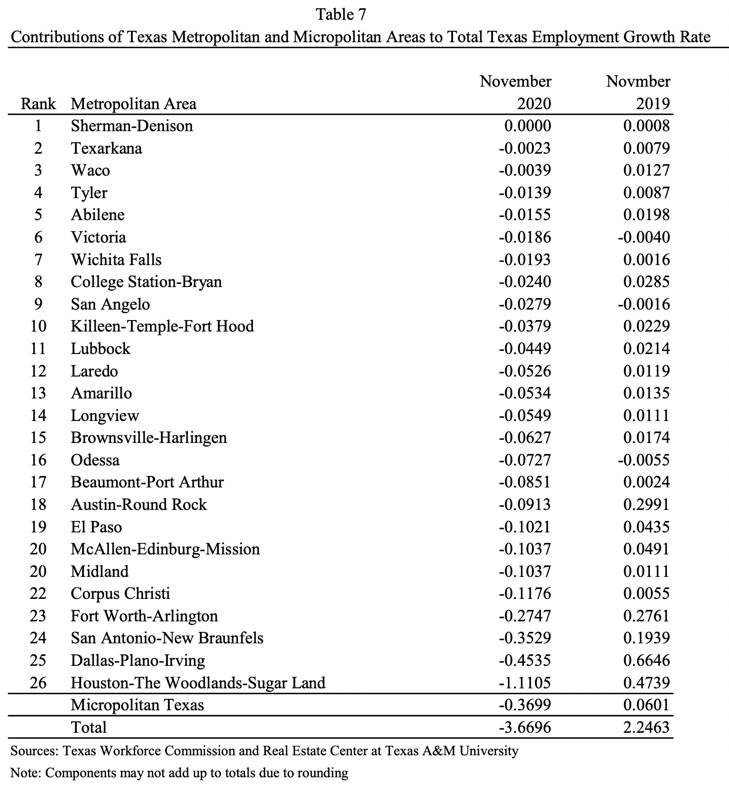
Unemployment Rate by Metropolitan Area
The state’s actual unemployment rate in April 2018 was 3.8 percent. Midland had the lowest unemployment rate followed by Amarillo, College Station-Bryan, Austin-Round Rock, Lubbock, and Odessa (Table 8).

Employment Growth Rates by Industry in Largest Texas Metropolitan Areas
Table 9 shows annual growth rates of employment by industry in the six largest Texas metropolitan areas from April 2017 to April 2018. Houston-The Woodlands-Sugar Land posted positive employment growth rates in its government sector and in all industries except the information industry. Dallas-Plano-Irving is currently experiencing positive employment growth rates in all industries as well as the government sector. San Antonio’s economy is currently driven by mining and construction, leisure and hospitality, professional and business services, education and health services, and manufacturing. Fort Worth-Arlington’s economy is currently experiencing job growth rates in all industries except information and other services. Government is the only sector in Austin experiencing job losses. The El Paso economy is currently driven by mining and construction, education and health services, and leisure and hospitality.
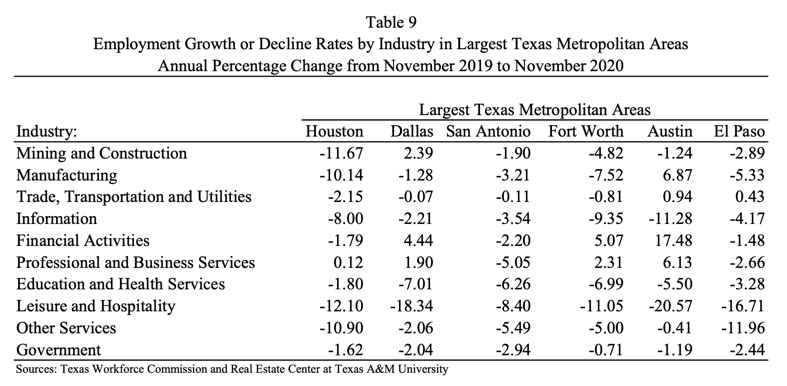
As always, if you need any help with your real estate needs, please contact Moira today at 817-343-5531.
